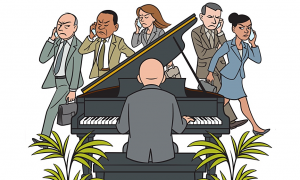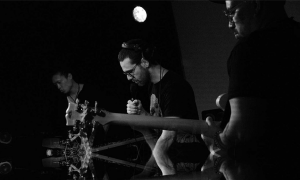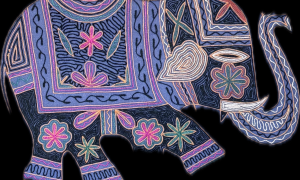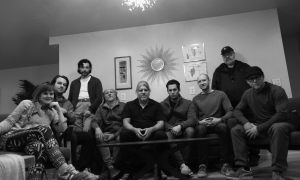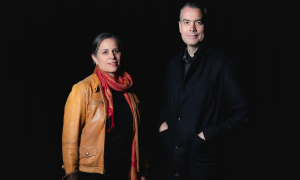Terry and I have been close friends since the mid-1990s. That's when we started getting together quarterly on Saturday mornings to listen to great jazz recordings. In fact, Terry was the one who, in July 2007, turned to me during one of these sessions and insisted I start a jazz blog. A few Saturdays ago, just before Pops was published, Terry came over and we talked at length about Louis Armstrong and the many questions I had about the sometimes controversial trumpeter and singer.
In Part 1 of my conversation with Terry, 53, the author of Pops talks about Armstrong's off-stage personality, what surprised him most after gaining access to Armstrong's 650 private tapes, the origins of Armstrong's passion for simplicity and desire to please audiences, and why the trumpeter's stage act must be viewed in its proper context:
JazzWax: Writers take on biographies to solve mysteries. What did you want to resolve with Armstrong?
Terry Teachout: I wanted to know whether the man we saw on stage and in film was the same man off stage. Until now, we've generally viewed Armstrong only through his performances. On record, film and television, Armstrong has a strong, clear and perfectly articulated character. We know him and we identify with hm. I was curious to know what he was really like off-stage, what made him tick. [Photo of Louis Armstrong by Herb Snitzer]
JW: How did you plan to get to know someone who was larger than life and has been dead since 1971?
TT: Fortunately, I had access to the roughly 650 private tapes Louis recorded over the last 25 years of his life. I'm the first Armstrong biographer to make full use of them. I knew that with access to the tapes, there was a good chance I would get a shot at pulling the veil aside and seeing what Armstrong had been like in private life as a personality.
JW: What did you discover?
TT: That the private Armstrong, while consistent with the public one, was a much richer and more complicated personality. There were sharper edges, and he was far more outspoken than was known previously. Through the tapes, Armstrong became a completely three-dimensional character.
JW: Does your discovery upend the public image we currently have of Armstrong as a jovial entertainer?
TT: Not at all. There's nothing false about the public Armstrong. He truly was a wonderfully genial, kind and expansive person. And those qualities aren't just the tip of the iceberg with Armstrong. They're three-quarters of the iceberg. The other quarter is a different story, and readers of Pops will discover that other side.
JW: What surprised you most?
TT: Louis Armstrong was a man who could hold a grudge, and he held some of them for most of his life. In addition, Armstrong was not in any way an Uncle Tom as described by younger musicians such as Dizzy Gillespie, who should have known better. In fact, Armstrong was very clear and open-eyed about race relations, in both directions. He is as explicit and as startled and angry about blacks' behavior toward whites as he was about whites' behavior toward blacks. And while we already knew how widely curious Armstrong was about music, you see in Pops how open he was to every type of music and how influenced he was by them.
JW: What did Armstrong understand about simplicity that was lost on so many other musicians?
TT: Simplicity is absolutely central to Louis' development as an artist. Louis started out as a young virtuoso who was in love with the sound of his own horn. When you can play anything you hear, you want to hear yourself play. Louis apprenticed with King Oliver [pictured], who ingrained in him the centrality of melody to the jazz musician. Armstrong's exposure to Oliver and his view of melody made him feel that it was not only appropriate to embrace simplicity but also vital to appeal to audiences in an immediate way.
JW: But Oliver was certainly less technically gifted than Armstrong.
TT: That's true. Yet it's Oliver who made Armstrong believe it was far better to be simple than complicated. Armstrong internalized these lessons at age 21, and he lived by them throughout his career.
JW: Did Armstrong's passion for pleasing audiences come from within or in reaction to life events?
TT: Both. Remember, Louis comes to Chicago from New Orleans at age 21. Up to that moment, he's only known in New Orleans. Once he's up North in this larger city, he starts making records and emerges as a public figure. At that moment, he becomes himself, the person he was his entire career.
JW: And who was Armstrong at that moment?
TT: From age 21 on, Louis liked being an entertainer. He liked applause. He liked giving pleasure for its own sake. He didn't think there was anything incompatible with being an entertainer and being a perfectly serious artist. In fact, for Armstrong, the two were as one. Interestingly, Armstrong didn't generally talk of himself as an artist but occasionally he did. We know from what he said that he believed in the seriousness of what he was doing.
JW: Was Armstrong's mugging and vaudeville persona the idea of his manager Joe Glaser?
TT: No, not at all. Louis was always that way. He was dancing on stage with King Oliver's Creole Jazz Band in the early 1920s. He saw dancer Bill “Bojangles" Robinson on stage around that time and was powerfully influenced by his act. And, as we know from Louis' own testimony, he was singing before he was playing the trumpet. There was never a time when Armstrong wasn't presenting himself as a stage performer.
JW: Many people today cringe at his singing, viewing it as a form of cultural and racial appeasement.
TT: Not true. Armstrong sang in that style from an early age. It was part of him. Remember, his first real break occurs playing in the orchestra pit of Hot Chocolates on Broadway in 1929 and he is singing Ain't Misbehavin' in the show. He's not playing a Haydn concerto here or a form of proto-bebop. He's singing and playing in a musical. It was entertainment.
JW: What role did Glaser play in helping to shape Louis' showman persona in the late 1930s and 1940s?
TT: Glaser, I think, wanted to streamline and, in some ways, simplify Louis' act. This is especially true of Louis' singing. Glaser wanted to make it more intelligible and commercially marketable to a wider audience, specifically a white audience. But Glaser wasn't trying to get Armstrong to do anything that he wasn't already doing. Even back in Chicago, when Glaser was still running whorehouses for Al Capone, Armstrong was doing a stage act that was bawdier than what we know about him from performances on The Ed Sullivan Show. [Photo of Joe Glaser and Louis Armstrong in 1965 by John Leongard for Life]
JW: What was he doing?
TT: A drag comedy with drummer Zutty Singleton [pictured]. So as far as what Louis did on stage, no one made him do anything that he didn't want to do. Singing the way he did was what he did, and liked doing it. It just happened to be captured on record. Louis also happened to be an entertainer who was a genius. Everything he sings, even the most popular songs, is touched and illuminated by his musical genius.
JW: So why does Armstrong, the entertainer, make so many jazz listeners today instinctively uncomfortable?
TT: Because they're not seeing Armstrong in a historical perspective. They forget that Louis was born in 1901 in New Orleans. Because he lived as long as he did, into the age of TV, and performed on-camera regularly, we think of Louis as a more contemporary figure than he really is.
JW: But wasn't his act something of a relic, even in its time?
TT: Not quite. Remember when Armstrong was singing and mugging in the 1920s, black audiences liked what he was doing just as much as white audiences did. This kind of comedy wasn't something Armstrong was doing to pander to white audiences. He was doing it because it appealed to black audiences--his original audience.
JW: For example?
TT: If you look at Louis Armstrong and His Hot Five in the mid-1920s, you realize there are as many comedy numbers like Big Butter and Egg Man from the West and King of the Zulus as instrumentals. Yes, they were on OKeh, Columbia's so-called race-record line. But they were meant for a black market and were immensely popular with this market. You have to realize that Armstrong was giving people what they wanted and doing what he liked to do. He was a man with a broad, robust sense of humor who was shaped by seeing Bert Williams [pictured], the great black vaudeville comic in the early 20th century, Bojangles Robinson and all of these entertainers. He saw himself as being like them. To begin to fully appreciate Louis' genius, one must understand the cultural context of his development and entertainment values of his time.
Tomorrow, Terry talks about the origin of Armstrong's nickname, why Armstrong became the most famous figure in jazz and Coleman Hawkins and Bix Beiderbecke did not, bebop's negative reaction to Armstrong's passion for entertaining, and the roots of Armstrong's feud with Dizzy Gillespie.
JazzWax tracks: Louis Armstrong's output from the 1920s is best documented on The Complete Hot Five and Hot Seven Recordings (Sony) box here.
JazzWax pages: Terry Teachout's Pops: A Life of Louis Armstrong (Houghton Mifflin Harcourt) is a must-read for anyone who is even causally curious about Armstrong. The book's subtitle could easily have been Why Louis Armstrong Still Matters. For writers of biographies, it's a case study of jazz scholarship, demonstrating how to take a larger-than-life jazz figure and turn that person's life into a dramatic story without sacrificing any of the details. Pick any two pages of this biography and see for yourself how Terry casualy weaves in key details gleaned from in-depth research. The book is available online here.
JazzWax clip: Here's Louis Armstrong's Big Butter and Egg Man from the West (1926), an early example of his singing style and playing...
This story appears courtesy of JazzWax by Marc Myers.
Copyright © 2025. All rights reserved.

















